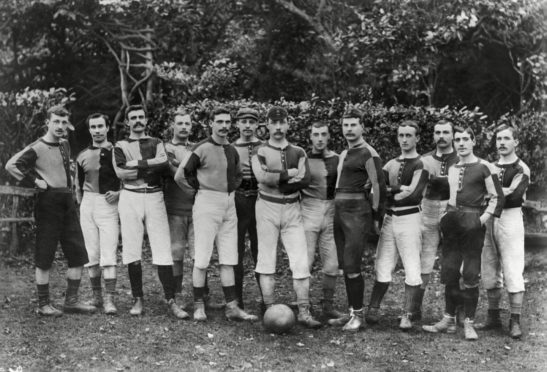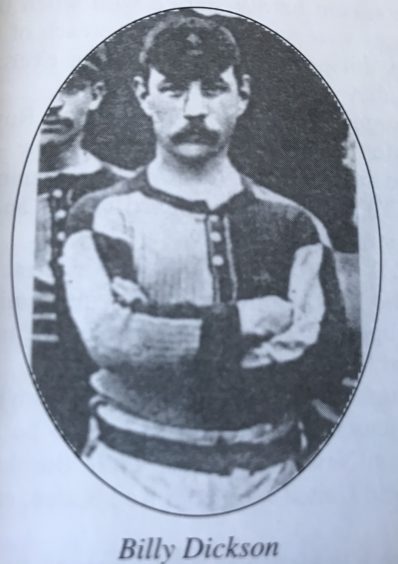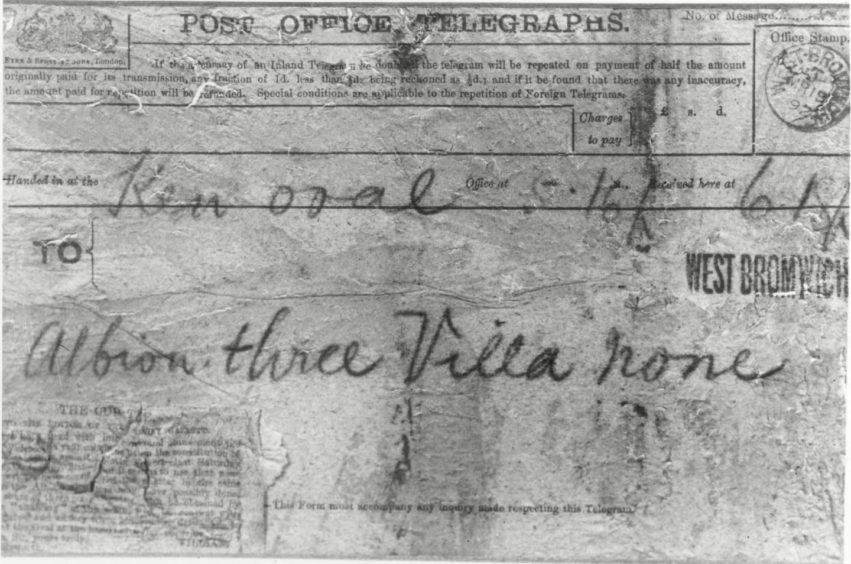He is the Tayside football hero who was considered the greatest Scottish centre-forward of his day.
William Dickson was one of Dundee’s finest football exports but his exploits are all but forgotten in the city where he started his career.
Dickson scored four goals on his debut for Scotland against Ireland and went on to become a great servant for Stoke City where his name is entwined in the history of the club alongside Gordon Banks, Sir Stanley Matthews and Peter Shilton.
Stoke City 7 Newton Heath 1. Jan 1893. Billy Dickson scored a hat-trick at the Victoria Ground #Div1 pic.twitter.com/TT9dWFX2j0
— Michael H (@MikeH1964) July 8, 2016
One of the first Scottish exponents of the game to join an English club, the former Dundee Strathmore player’s achievements are being put in the spotlight once again to mark 110 years since he passed away at the age of just 43 from kidney disease.
He was born as William Alexander McFarlane in Rattray, Perthshire, in 1866 to Isabella McFarlane.
His mother then married John Dickson who was a railway signalman.
He started his playing career with Dundee Strathmore after being asked to “have a kick” while watching a practice match at Rollo’s Pier.
Dickson first played at left half-back but had shown his goal-getting capability by repeatedly scoring goals and got his chance at centre-forward in a Charity Cup game against the Wanderers in unusual circumstances.
Strathmore were struggling to find a good centre-forward and asked Dick Steven to play up front.
Steven had just joined from West End and was not enamoured by the idea because he was usually a half-back.
On the way on to the field Steven and Dickson agreed that one should play centre-forward in the first half and the other in the second.
Dickson performed so well when the game started that the change was never made.
After gaining his place in the Strathmore team he was never displaced, and started to make a name for himself.
His performances eventually attracted the attention of the Scottish selectors.
He was chosen to play against Ireland in 1888 where he scored four times in a 10–2 win.
However, the selectors were not impressed and he was never chosen again.
Dickson is one of just two players to have scored four goals in their only Scotland appearance.
Several English teams made inquiries about his services including Everton.
In the autumn of 1888 he went to Sunderland under what was then the six-week rule and returned to Strathmore where he finished the season.
Dickson was a boiler maker but things were dull in the city and the prospects were not at all satisfactory.
Aston Villa were the next club to come on the scene, and Dickson was enticed over the border despite a great effort by Strathmore to keep him.
He played for Villa for three years and played in the team which got all the way to the FA Cup Final in 1892 where they played West Bromwich Albion.
The FA Cup Final was the last played at Kennington Oval in Lambeth – now the Oval Cricket Ground – and proved to be one of the greatest upsets ever known.
Lord's has never hosted football games, but The Oval saw plenty of FA Cup action, thanks to the competition's creator, @FA & @surreycricket sec C.W. Alcock.
In 1892, @WBA (navy & white) defeated @AVFCOfficial (claret & blue) in the last Oval final. No cricket whites in sight. 🏏 pic.twitter.com/VBktQzT4Au
— Nat. Football Museum (@FootballMuseum) June 25, 2019
Villa had beaten league champions Sunderland in the semi-final and put up a record league score the Saturday before the cup final.
West Brom however outplayed Villa and won 3-0 in front of 30,000 fans in the 1892 final which was the first to be contested using nets attached to goal posts.
Goalkeeper Warner came in for heavy criticism as his display was very poor and there was crowd trouble at full-time because many fans thought the match had been sold.
A rumour began to circulate that he had placed hefty bets on Albion to win the cup and then contrived to throw the game.
This accusation made the press and while no action was ever taken against Warner, his career at Villa was over and Newton Heath signed him for a snip for their first campaign in the new second division.
A Villa man through and through, Warner eventually quit football and left the country, moving to Philadelphia with his daughter to get away from the rumours.
Dickson played 64 games in total for Aston Villa where he partnered the speedy Charlie Athersmith and scored 34 goals before moving to Stoke in 1892.
Stoke City FC 1892/93 pic.twitter.com/Qh6x1odVST
— ⚽🇬🇧 Alberto Feal (@AlfBertinho) April 16, 2020
During his playing career in England Dickson was recognised as one of the finest forwards who ever left Scotland for an English club.
He was an ever-present in seasons 1892-93 where he scored 11 goals as Stoke enjoyed their best season in the league up to that point.
He scored 13 in the following campaign including five in six in the short lived United Counties League.
Dickson was also ever-present in the 1895-96 campaign where he also played at full-back and would swap positions on a regular basis.
He retired in 1896 but remained in Stoke where he was engaged in the licensing business.
He was mine host of the Prince of Wales Inn on Liverpool Street.
Dickson went on to become a director of the club following financial difficulties in 1908 after it was liquidated and in danger of disappearing completely.
However, local feeling was roused at the eleventh hour and monies were raised by 12 local businessmen and a new board was formed, of which Dickson was a member.
Stoke club historian Colin Burgess said Dickson played 134 games for the Potters and scored 48 times before retiring.
“He was a striker of the highest quality and a great servant to the club both on and off the pitch,” he said.
“His name will always be entwined in the history of Stoke City.”
Dickson was in Dundee in March 1910 for the silver wedding celebrations of his brother-in-law John Robertson.
It was observed that he was not looking at all well and he was practically confined to his house after returning to Stoke.
He died of Bright’s disease on June 1 and left a widow and six children.
Dickson left £2,092 to his widow Jessie when he died.












